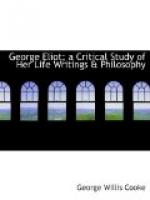The literary excellences of the Scenes from Clerical Life are many. They are simple, charming stories, full of life, and delightful in tone. Their humor is rare and effective, never coarse, but racy and touching. Their tenderness of tone lays warm hold upon the reader’s sympathies and brings him closer to the throbbing hearts of his fellow-men. There is a pure idyllic loveliness and homelikeness about these stories that is exquisite. They all evidently grew out of the tender memories and associations of George Eliot’s girlhood.
In Adam Bede the author’s purpose is concentrated on character and the moral unfoldment of the lives she describes, while the thorough dramatic unity is lacking which such a work demands. It is a delightful picture of country life, and for idyllic loveliness is scarcely equalled, never surpassed, in English literature. The charm of the narrative is only rivalled by the deep human interest the characters have for us. This exquisite picture of rural life is not merely a piece of fine painting; but the deepest problems, the largest human interests, ever appear as a perpetual background of spiritual reality, giving a sublimity to the whole that truly dignifies it. The thoughtful reader soon finds this inweaving of a larger purpose adding greatly to the idyllic loveliness of these scenes. The moral tone is clear and earnest, and the religious element gives a charm and nobility to this delightful picture of rustic simplicity.
Adam Bede has probably delighted a larger number of her readers than any other of George Eliot’s books, and even a majority of her critics prefer it to any other. It at once arrests and fixes the attention of the reader. The first chapter has an immediate interest in its wonderful picture of Adam, and its most vivid description of the workshop. The second chapter, with its account of Dinah Morris and her preaching, leaves no possibility of doubt about the genius and power of the book. The reader




